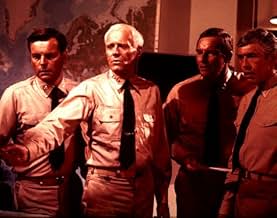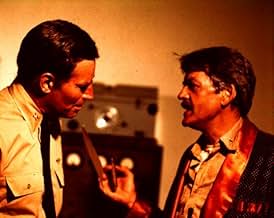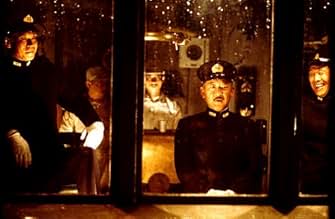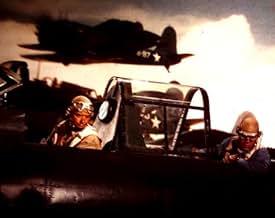AVALIAÇÃO DA IMDb
6,8/10
22 mil
SUA AVALIAÇÃO
Uma dramatização da batalha que foi amplamente anunciada como um ponto de viragem no Teatro do Pacífico da Segunda Guerra Mundial.Uma dramatização da batalha que foi amplamente anunciada como um ponto de viragem no Teatro do Pacífico da Segunda Guerra Mundial.Uma dramatização da batalha que foi amplamente anunciada como um ponto de viragem no Teatro do Pacífico da Segunda Guerra Mundial.
Toshirô Mifune
- Admiral Isoroku Yamamoto
- (as Toshiro Mifune)
Avaliações em destaque
As many others have stated, the flaws in this film are many. There is the unnecessary subplot of an American aviator and his interned Japanese/American girlfriend, which serves as nothing more than a gratuitous distraction. Limits in 1976 technology forced the use of cheap-looking special effects and recycled footage from other movies and war footage, often resulting in incorrect historical portrayals of the ships and aircraft present. Some historical plot details were omitted or glossed over entirely, mostly due to production and budget limits. And the acting was uneven, and in a few parts pretty bad, and sometimes failed to realistically portray a few figures.
But there are few war movies that can generate as much excitement in me to this day like this one. I first saw this movie as a two-part NBC Movie of the Week when I was ten years old and instantly developed a passion for the Battle of Midway and WWII military history in general. The climatic scene of the dive bombers pounding the Japanese carriers into wrecks still gives me goosebumps thirty-five years later, as does the horror of watching a young fighter pilot nearly burn to death in his plane. The John Williams score was fantastic, as it was in many movies, and kept the sense of drama on the edge. And for me, the standout performances were by Henry Fonda as Admiral Nimitz, Glenn Ford as Admiral Spruance, and James Shigeta as Admiral Nagumo. Fonda brought to life Nimitz's cool but tough demeanor, and his willingness to take calculated risks based on his intelligence sources, rather than play it safe and guard what he has left. Ford played Spruance well as a calm, cerebral admiral that plays by his own instincts rather than the way the man he replaced (Halsey) would've played it. And I enjoyed Shigeta's portrayal of Nagumo as a leader who, despite his perceived material superiority, is wary of the lack of intelligence and communication regarding the whereabouts of the American fleet, and the uncertainty of what really may be waiting for his carriers as he undertakes his mission.
It's real easy to pick apart the historical details of this movie, especially given more recent information and sources that weren't available back in 1976. But even allowing for that, the movie stays mostly true to history. And to those who aren't looking to nitpick details and just want to enjoy the story being told, there's more than enough "wow" in this movie even almost forty years later. I would recommend it as a primer for young kids (but not too young, there is some blood, language, and tense scenes) with an interest in military and WWII history that hasn't yet researched more comprehensive works written like Walter Lord's Incredible Victory, Gordon Prange's Miracle at Midway, and Anthony Tully/Jonathan Parshall's Shattered Sword.
I would like to see Hollywood do another adaptation of the battle of Midway someday, but am fearful of them turning it turning into another Pearl Harbor, or becoming a political statement rather than the retelling of an incredible true story. Until that day comes, this one will have to do. And it does surprisingly well, if you can tolerate the flaws and just enjoy the show.
But there are few war movies that can generate as much excitement in me to this day like this one. I first saw this movie as a two-part NBC Movie of the Week when I was ten years old and instantly developed a passion for the Battle of Midway and WWII military history in general. The climatic scene of the dive bombers pounding the Japanese carriers into wrecks still gives me goosebumps thirty-five years later, as does the horror of watching a young fighter pilot nearly burn to death in his plane. The John Williams score was fantastic, as it was in many movies, and kept the sense of drama on the edge. And for me, the standout performances were by Henry Fonda as Admiral Nimitz, Glenn Ford as Admiral Spruance, and James Shigeta as Admiral Nagumo. Fonda brought to life Nimitz's cool but tough demeanor, and his willingness to take calculated risks based on his intelligence sources, rather than play it safe and guard what he has left. Ford played Spruance well as a calm, cerebral admiral that plays by his own instincts rather than the way the man he replaced (Halsey) would've played it. And I enjoyed Shigeta's portrayal of Nagumo as a leader who, despite his perceived material superiority, is wary of the lack of intelligence and communication regarding the whereabouts of the American fleet, and the uncertainty of what really may be waiting for his carriers as he undertakes his mission.
It's real easy to pick apart the historical details of this movie, especially given more recent information and sources that weren't available back in 1976. But even allowing for that, the movie stays mostly true to history. And to those who aren't looking to nitpick details and just want to enjoy the story being told, there's more than enough "wow" in this movie even almost forty years later. I would recommend it as a primer for young kids (but not too young, there is some blood, language, and tense scenes) with an interest in military and WWII history that hasn't yet researched more comprehensive works written like Walter Lord's Incredible Victory, Gordon Prange's Miracle at Midway, and Anthony Tully/Jonathan Parshall's Shattered Sword.
I would like to see Hollywood do another adaptation of the battle of Midway someday, but am fearful of them turning it turning into another Pearl Harbor, or becoming a political statement rather than the retelling of an incredible true story. Until that day comes, this one will have to do. And it does surprisingly well, if you can tolerate the flaws and just enjoy the show.
This was one of my favorite movies when I was growing up and building models of land, sea, and air craft of the WWII period. Of course we all could have done without the romantic interest, but what counts is the overall telling of the story accurately (even if that includes sideline dramatizations etc.). In a nutshell Midway was a gamble and even though we knew where they'd be, we still took it on the chin with the loss of most of the aircraft and the Yorktown (which left only 2 effective carriers in the pacific and 1 in drydock). In the end we were lucky enough to be able to inflict sufficiently more damage on them than they did on us. This is the story that is told so well. It doesn't matter that the special effects were less than stellar (e.g., view of the fleet from the sealevel - obvious miniatures) or that they showed Essex class carriers which did not yet exist getting hit by kamikaze. The film is true in its depictions of gambles, gaffs, and good fortune which in the end allowed us to be victorious and end Japanese expansion. So quit knocking it and enjoy it for what it is!
I first saw this movie when it was opening as a 10 year old boy who was enamored with WWII. At that time to me, it was one of the best war movies I had ever seen. Due to my prior readings on the battle, I knew it followed the history fairly well, and I was able to tune out the romance sub plot. The look of movie was something that was something I was not familiar with in war movies up to that point. The indoor officers were in nice neat uniforms, while the pilots, Marines, and common sailors had a weary rumpled look. And the language! I had not yet heard so much cursing in a war movie (it was 1976 and for the most part John Wayne type movies were the norm). But I loved it all! I knew most of the planes shown on screen were not accurate, and much of the combat footage was from later in the war. But it showed a different type of war movie. The Japanese were strong, smart, and nearly invincible. Not monsters or maniacs, but allowing overconfidence at times to cloud some decisions. The Americans were brave, novices, unsure of themselves at times, yet determined not to fail, no matter the cost. Not the overpowering unbeatable force of years to come later in the war. Watching during the initial phases of combat as obsolete US planes were shot down one by one by the superior Japanese fighters, I was captivated by the self sacrifice(a year later the ending dogfight in Star Wars would make me think of Torpedo 8). Then the tide turned as events, luck, and timing change the course of battle. In the end, the US wins, the Japanese are defeated, and survivors ponder the results and reasons why briefly. Flash forward 32 years later and I watch this movie again on my DVD copy on the 66th anniversary of the battle. This movie holds up not too badly against the test of time. Much time has passed in by movie making and in my gaining knowledge of this subject. To me the strengths still hold, as do the weaknesses. The interracial romance subplot is certainly a 70s addition. Certainly not believable in a historical context. The stock footage of aircraft certainly still glares in error as well. Color footage was shot during the battle and released in a documentary. A small amount was incorporated into the movie. Much more could have replaced other sequences that were used in the movie. Many of the Tora!Tora!Tora! conversion aircraft were still local to Universal Studios at Orange County or Chino airports at the time of filming. Some were used in the Midway Island bombing sequence, but not in the Yorktown attacks. Too bad they did not make more use of them for a better look. The Japanese film sequences from "Storm Over the Pacific" actually worked very well for their capturing the look of the Japanese carriers and the activities on board. As did the lifted opening from "30 seconds Over Tokyo". Much of the dialog on film is true to life with certain quotes historically accurate. "Look at that b*****d burn", was the first radio message clearly heard on the US carriers letting them know any of the air strikes had made contact and been successful. It also holds up sticking fairly close to the time line of actual events, but there are several events omitted. Finally the effects were not bad. For pre CGI the choices are to build full scale mocks ups, use an area or item that has a resemblance or miniatures. All three methods were used to good effect. And the results were for the most part just as good as, if not better than the more modern (film making wise) CGI heavy "Pearl Harbor". All in all, a decent war movie, still worth watching, flaws and all.
A critical part of WWII gets the big epic cinematic treatment, with all star casting and lots of noise. Though purporting to be exactly how things were during this particular battle, a pinch of salt is also needed. Much of the film is taken up with laying foundations for the air-sea engagement of the title, political posturing and military machinations are joined by needless sub-plots. The dialogue is often cheese laden, some characterisations equally so, while the splicing of real life footage and other war movie moments start to detract. However, the last third of film is thrilling and worth waiting for, a whirl of battle action as the Pacific conflict comes vividly to life both visually and aurally. 6.5/10
I can't help but agree with most of the other comments: the sloppy production values, the scenes "borrowed" from better movies, the countless anachronisms, the distracting subplot about Lt. Garth and his Japanese girlfriend, and so on. But for me, this movie has two strong points in its favor. One, when they get around to the actual battle, they follow the history with surprising accuracy. (The "Pearl Harbor" makers could have learned something from this one.) So the movie's hard to follow? So was the actual battle! Personally, I think they did a pretty good job of keeping the flow coherent while still remaining faithful to its source material.
The second thing in its favor is that, from the moment I first saw it in the theater as a 10 year old, it ignited in me a passion for the Battle of Midway that remains to this day. I can't think of any other movie that even comes close to getting me as hooked on its subject as this one. Maybe it's a good thing I first saw it when I was young, when I was much less discerning about production values, etc. That way, I could concentrate on the story itself.
If you have even the slightest interest in military history or even in important historical events in general, do yourself a favor. Watch "Midway" to get an overview of the event (fast-forward over the love-story scenes if you like), then go read "Incredible Victory" by Walter Lord (which is a better book than the one for which he is most famous, "A Night to Remember"). You won't be sorry.
The second thing in its favor is that, from the moment I first saw it in the theater as a 10 year old, it ignited in me a passion for the Battle of Midway that remains to this day. I can't think of any other movie that even comes close to getting me as hooked on its subject as this one. Maybe it's a good thing I first saw it when I was young, when I was much less discerning about production values, etc. That way, I could concentrate on the story itself.
If you have even the slightest interest in military history or even in important historical events in general, do yourself a favor. Watch "Midway" to get an overview of the event (fast-forward over the love-story scenes if you like), then go read "Incredible Victory" by Walter Lord (which is a better book than the one for which he is most famous, "A Night to Remember"). You won't be sorry.
Você sabia?
- CuriosidadesKevin Dobson's character Ensign George Gay, was the sole survivor of Torpedo Squadron 8. Gay wrote a book about his experiences (Sole Survivor) and was an advisor on this film.
- Erros de gravaçãoWhen the cockpit of one of the planes catches fire, the pilot pulls out a fire extinguisher. It is a more modern one, not a fire extinguisher that would have existed in the 1940s.
- Citações
Vice Adm. Chuichi Nagumo: [commenting on the American torpedo bombers] They sacrifice themselves like samurai, these Americans.
- Versões alternativasA television version exists, with additional cast and plot. It runs four hours with commercials. The main plot points are a Charlton Heston-Susan Sullivan romance and the Coral Sea battle (reffered to in the other version) is played out like the Midway battle. The Coral Sea battle heavily features Mitchell Ryan as Admiral Aubrey Fitch and also includes a subplot where a young Japanese pilot who'd met with Admiral Nagumo to express his opposition to Japanese military action is shot down. At the end of the TV version, Sullivan and Christine Kukobo are both shown waiting dockside.
- ConexõesEdited from Assim é a Glória (1943)
- Trilhas sonorasIn the Mood
Music by Joe Garland
Performed by the Glenn Miller and His Orchestra (as Glenn Miller Orchestra) on the jukebox at the bar in Hawaii
Principais escolhas
Faça login para avaliar e ver a lista de recomendações personalizadas
- How long is Midway?Fornecido pela Alexa
Detalhes
Bilheteria
- Faturamento bruto nos EUA e Canadá
- US$ 43.220.000
- Fim de semana de estreia nos EUA e Canadá
- US$ 4.356.666
- 20 de jun. de 1976
- Tempo de duração2 horas 12 minutos
- Cor
- Proporção
- 2.39 : 1
Contribua para esta página
Sugerir uma alteração ou adicionar conteúdo ausente

Principal brecha
By what name was A Batalha de Midway (1976) officially released in India in English?
Responda





































